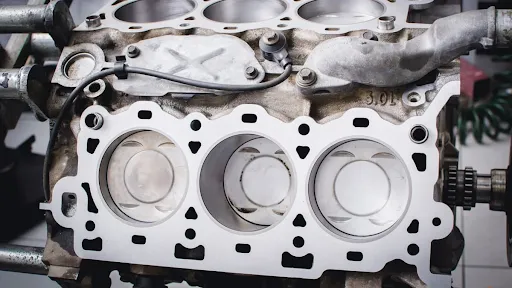Mon - Fri: 8am - 5pm, Sat - Sun: Closed

6-36 Month Warranties
We Ship Local.
Hablamos Español.
Connect with
Engine Remanufacturing Process
Engine Remanufacturing Explained
What is the Process for Remanufacturing an Engine?

Engine remanufacturing stands as a pinnacle of automotive recycling, where used engines are meticulously restored to original factory specifications. This process involves disassembling, cleaning, inspecting, repairing, or replacing components, and reassembling the engine to create a product that matches or surpasses the quality of a new engine.
In the automotive industry, remanufacturing is pivotal for its economic and environmental benefits. It offers a cost-effective solution for extending vehicle life and reduces waste and the need for new raw materials, aligning with sustainable practices.
For consumers and manufacturers alike, engine remanufacturing represents a convergence of value, performance, and responsibility.
Step-1: The Initial Assessment:
The engine remanufacturing process begins with a thorough initial assessment, where the engine is carefully disassembled into its constituent parts. Each component is tagged and cataloged to ensure a meticulous rebuild.
This stage is critical, as it lays the groundwork for the entire remanufacturing procedure. Following disassembly, the components undergo a rigorous cleaning process, utilizing specialized equipment and solvents designed to remove accumulated grime, oil, and any contaminants that could compromise the integrity of the rebuild.
This cleaning not only prepares each part for detailed inspection but also reveals any hidden flaws that might not be visible under layers of dirt and old engine residue. It's a foundational step in the engine remanufacturing process, setting the stage for the precise work to follow.
Step-2: Inspection and Testing:
Once the engine is disassembled and its components are cleaned, the reman process for car engines moves into a critical phase: inspection and testing. Each part is scrutinized against OEM standards for wear, damage, and integrity.
Technicians use a variety of precision tools, from micrometers to gauge blocks, to measure tolerances and ensure each piece meets stringent specifications. Components like connecting rods, crankshafts, and cylinder heads are examined for microfractures using non-destructive testing methods such as magnaflux or ultrasonic testing.

The testing extends to systems that can be electrically evaluated, such as ignition and fuel injection components, to confirm their operational efficacy. If any part fails to meet the required criteria, it is either reconditioned to the correct specifications or replaced entirely with a new one.
This meticulous inspection and testing ensure that the remanufactured engine will perform as expected, providing reliability and longevity on par with a new engine. It's a testament to the thoroughness of the remanufacturing process, where nothing is left to chance, and every component is guaranteed to contribute to the engine's overall performance and durability.
Step-3: Machining and Reconditioning:
In the car engine reman process, machining and reconditioning are pivotal steps that restore engine components to their optimal condition. This phase involves precision machining techniques that refurbish parts to exact specifications.
Cylinder blocks are resurfaced and bored to ensure a smooth and precise area for the pistons to operate. Crankshafts are ground and polished to eliminate any imperfections that could impair functionality. Cylinder heads are planed to guarantee a perfect seal with the engine block, preventing any potential for compression loss or gasket failure.
The reconditioning process also includes the refurbishment of valves, camshafts, and connecting rods, ensuring each moves with the intended precision and smoothness. This meticulous attention to detail in the machining phase is crucial, as it directly impacts the engine's performance, efficiency, and longevity.
By adhering to strict remanufacturing protocols, worn components are transformed back to like-new condition, ready to deliver robust performance. The car engine reman process, through its comprehensive machining and reconditioning stages, ensures that the final product is not just rebuilt, but remanufactured to meet the highest standards of quality and reliability.
Step-4: Replacement of Parts:
During the remanufacturing process for engines, certain parts are invariably replaced rather than reconditioned. This is due to either excessive wear or because they are critical for the engine's reliability and performance. Commonly replaced items include bearings, gaskets, seals, and O-rings, which are essential for maintaining tight clearances and preventing leaks. Timing chains or belts, along with their tensioners and guides, are also typically replaced to ensure accurate valve timing and operation.
In addition to these, the oil pump, which is vital for maintaining proper lubrication throughout the engine, is often replaced with a new one to guarantee efficient operation. Pistons and rings might be substituted to restore compression and reduce the likelihood of oil blow-by. Valves, springs, and lifters are frequently renewed to maintain optimal engine breathing and function. The replacement strategy is a critical component of the remanufacturing process, ensuring that each engine not only runs like new but will also have a comparable lifespan to a brand-new engine, providing customers with both confidence and value.
Step-5: Reassembly and Quality Control:
Reassembly is a stage in engine remanufacturing where precision and attention to detail are paramount. Following the replacement and reconditioning of parts, each component is methodically put back together according to OEM specifications. Technicians employ torque wrenches to ensure every bolt is tightened to exact standards, and specialized tools are used to align components perfectly, ensuring smooth operation. The reassembly process is not just about putting parts together; it's about restoring an engine's intricate harmony.
Quality control is integral to engine remanufacturing and is woven into every step of the reassembly. After the engine is reassembled, it undergoes a series of tests to ensure it meets all performance criteria. These tests can include compression checks, leak-down tests, and, if applicable, computerized simulations that run the engine through various operating conditions. Only after an engine passes all these rigorous quality control measures is it deemed ready for the market. This commitment to excellence ensures that a remanufactured engine delivers reliability and performance on par with a new engine, providing customers with a product they can trust.
Step-6: Testing and Certification:
The final testing phase is a crucial component of the remanufacturing engines process, where the rebuilt engine must prove its mettle. This phase involves a battery of tests, simulating real-world conditions to ensure every engine performs reliably under various stress levels. Engines are mounted on test stands where they are run, allowing technicians to monitor for any discrepancies in performance, such as irregular compression, oil leaks, or abnormal noises. Computerized diagnostics check for proper sensor function and electronic control unit (ECU) communication, ensuring the engine's brain is in sync with its mechanical components.
Once an engine passes all functional tests, it moves on to certification, a seal of approval that it meets or exceeds industry standards. Certifications can come from various bodies, including manufacturers and independent organizations, which assess the engines based on a set of rigorous criteria. This certification is not just a stamp of approval but a guarantee of quality and reliability. It assures customers that the remanufactured engine they are purchasing has been through an exhaustive process to ensure its performance and longevity are on par with a new engine, making it a smart and sustainable choice for their vehicle.
The Benefits of Remanufactured Engines
Opting for remanufacturing car engines offers significant cost savings compared to buying new, without compromising on quality. Customers benefit financially, while also contributing to environmental sustainability by reducing waste and conserving the energy and raw materials required to build a new engine. Reman car engines are not only a testament to resourcefulness but also to the innovation within the automotive industry, providing a reliable and eco-friendly solution. This approach extends the life of existing engines and supports a circular economy, making remanufactured engines an intelligent choice for both the consumer and the planet.
Get our latest news and promos
QUALITY ASSURED


SATISFACTION GUARANTEED

UNPARALLELED SUPPORT
Houston Engines
Proud Member



Social Media
Payments Accepted
Ship Via











